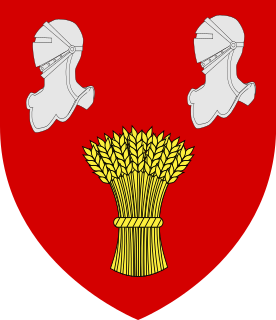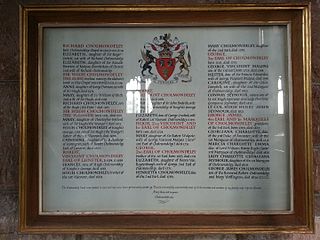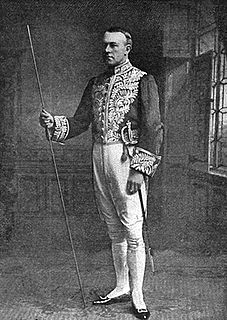
Earl of Winchilsea is a title in the Peerage of England held by the Finch-Hatton family. It has been united with the title of Earl of Nottingham under a single holder since 1729. The Finch family is believed to be descended from Henry FitzHerbert, Lord Chamberlain to Henry I. The name change to Finch came in the 1350s after marriage to an heiress by a member of the Finch family. In 1660 the 3rd Earl of Winchilsea was created Baron FitzHerbert of Eastwell, Kent, in recompense for his efficient aid in the Restoration of the Monarchy. The Herbert family of Wales, Earls of Pembroke, share common ancestry but bear differenced arms. A later member of the family, Sir William Finch, was knighted in 1513. His son Sir Thomas Finch, was also knighted for his share in suppressing Sir Thomas Wyatt's insurrection against Queen Mary I, and was the son-in-law of Sir Thomas Moyle, some of whose lands Finch's wife inherited. Thomas's eldest son Moyle Finch represented Weymouth, Kent and Winchelsea in the House of Commons. In 1611 he was created a baronet, of Eastwell in the County of Kent.

Earl of Lindsey is a title in the Peerage of England. It was created in 1626 for the 14th Baron Willoughby de Eresby. He was First Lord of the Admiralty from 1635 to 1636 and also established his claim in right of his mother to the hereditary office of Lord Great Chamberlain of England. Lord Lindsey fought on the Royalist side in the Civil War and was killed at the Battle of Edgehill on 23 October 1642. He was succeeded by his son, the second Earl. He also fought at Edgehill and surrendered to the Parliamentarians in order to attend his mortally wounded father. Lord Lindsey later fought at the First Battle of Newbury, Second Battle of Newbury, and at Naseby. His son from his second marriage, James, was created Earl of Abingdon in 1682. He was succeeded by his son from his first marriage to Martha Cockayne, the third Earl. He represented Boston in the House of Commons and served as Lord Lieutenant of Lincolnshire.

Marquess of Cholmondeley is a title in the Peerage of the United Kingdom. It was created in 1815 for George Cholmondeley, 4th Earl of Cholmondeley.

Earl of Rothes is a title in the Peerage of Scotland. It was created in 1458 for George Leslie, 1st Lord Leslie. He had already been created Lord Leslie in 1445, also in the Peerage of Scotland. His grandson, the third Earl, having only succeeded his elder brother in March 1513, was killed at the Battle of Flodden on 9 September of the same year. His son, the fourth Earl, served as an Extraordinary Lord of Session. Lord Rothes was also tried for the murder of Cardinal Beaton but was acquitted.

Earl of Melville is a title in the Peerage of Scotland. It was created in 1690 for the Scottish soldier and statesman George Melville, 4th Lord Melville. He was made Lord Raith, Monymaill and Balwearie and Viscount of Kirkcaldy at the same time, also in the Peerage of Scotland. He married Catherine Leslie, daughter of Alexander Leslie, Lord Balgonie, and granddaughter of Alexander Leslie, 1st Earl of Leven. Lord Melville was succeeded upon his death in 1707 by his eldest surviving son, David, who already in 1681 had succeeded to the earldom of Leven through his mother. The two earldoms have since remained united. For further history of the titles, see Earl of Leven.

Earl of Powis (Powys) is a title that has been created three times. The first creation came in the Peerage of England in 1674 in favour of William Herbert, 3rd Baron Powis, a descendant of William Herbert, 1st Earl of Pembroke. In 1687, he was further honoured when he was made Marquess of Powis.

Earl Granville is a title that has been created twice, once in the Peerage of Great Britain and once in the Peerage of the United Kingdom. It is now held by members of the Leveson-Gower family.
Earl of Bradford is a title that has been created twice, once in the Peerage of England and once in the Peerage of the United Kingdom. It was first created in 1694 for Francis Newport, 2nd Baron Newport. However, all the Newport titles became extinct on the death of the fourth Earl in 1762. The earldom was revived in 1815 for Orlando Bridgeman, 2nd Baron Bradford. The Bridgeman family had previously succeeded to the Newport estates. The title of the peerage refers to the ancient hundred of Bradford in Shropshire, and not, as might be assumed, to the city of Bradford, Yorkshire, or the town of Bradford-on-Avon in Wiltshire.

Baron Delamere, of Vale Royal in the County Palatine of Chester, is a title in the Peerage of the United Kingdom. It was created on 17 July 1821 for Thomas Cholmondeley, a former Member of Parliament for Cheshire. This Vale Royal branch of the Cholmondeley family descends from Thomas Cholmondeley, younger brother of Robert Cholmondeley, 1st Earl of Leinster and Hugh Cholmondeley (1591–1665), ancestor of the Marquesses of Cholmondeley. The first Baron was succeeded by his son. Before acceding to the title in 1855, the second Baron represented Denbighshire and Montgomery in the House of Commons as a Tory. His eldest son, also named Hugh, acceded to the title in 1887 and in the same year, he emigrated to Kenya, where he acquired a major estate. The third Baron's eldest son inherited his father's title in 1931. In 1934, he attempted to re-establish his family at Vale Royal, the family's country home and baronial seat from the 17th century; however, the great house was requisitioned as a sanatorium during the war years. When it was sold in 1947, the fourth Baron returned to Kenya. As of 2016 the title is held by the fifth Baron, who succeeded his father in 1979. He also lives in Kenya.

David George Philip Cholmondeley, 7th Marquess of Cholmondeley, ( CHUM-lee); born 27 June 1960), styled Viscount Malpas from birth until 1968, and subsequently Earl of Rocksavage until 1990, is a British peer and filmmaker. He also acts as Lord Great Chamberlain of the United Kingdom.

George James Cholmondeley, 1st Marquess of Cholmondeley,, styled Viscount Malpas between 1764 and 1770 and known as The Earl of Cholmondeley between 1770 and 1815, was a British peer and politician.

Earl of Leinster was a title in the Peerage of Ireland. It was created on 3 March 1646 for Robert Cholmondeley. He had already been created a baronet, of Cholmondeley in the County of Chester, in the Baronetage of England on 29 June 1611 and Viscount Cholmondeley in the Peerage of Ireland on 2 July 1628. He was created Baron Cholmondeley in the Peerage of England on 1 September 1648. Lord Leinster died childless in 1659 and the titles became extinct. However, the viscountcy of Cholmondeley was revived two years later in favour of his nephew Robert Cholmondeley, who is the ancestor of the Marquesses of Cholmondeley. Also, the Earl's other brother Thomas Cholmondeley was the ancestor of the Barons Delamere.

Robert Cholmondeley, 1st Earl of Leinster was an English Royalist and supporter of Charles I during the English Civil War.

Hugh Cholmondeley, 2nd Baron Delamere, styled The Honourable from 1821 until 1855, was a British peer and politician.
George Cholmondeley, Viscount Malpas was a British soldier and Member of Parliament.

Hugh Cholmondeley, 1st Earl of Cholmondeley, PC, styled The Honourable from birth until 1681 and then known as Viscount Cholmondeley to 1706, was an English peer and politician.

George Cholmondeley, 2nd Earl of Cholmondeley, PC, FRS, styled The Honourable from birth until 1715 and then known as Lord Newborough to 1725, was an English soldier. Cholmondeley was the second son of Robert Cholmondeley, 1st Viscount Cholmondeley, and Elizabeth Cradock. Hugh Cholmondeley, 1st Earl of Cholmondeley, was his elder brother. He was educated at Westminster School and Christ Church, Oxford. Cholmondeley supported the claim of William of Orange and Mary to the English throne and after their accession he was appointed a Groom of the Bedchamber.

Sir Hugh Cholmondeley was an English soldier.

George Henry Hugh Cholmondeley, 4th Marquess of Cholmondeley was a British peer and a hereditary joint Lord Great Chamberlain of England. He exercised the office of Lord Great Chamberlain during the reign of King Edward VII (1901–1910).
Cholmondeley is a surname. Notable people with the surname include:










